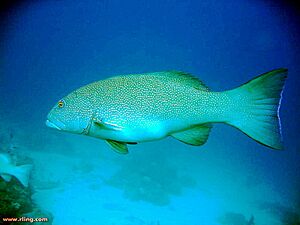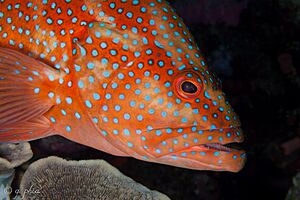Leopard coral grouper facts for kids
Quick facts for kids Leopard coral grouper |
|
|---|---|
 |
|
| Conservation status | |
| Scientific classification | |
| Synonyms | |
|
The leopard coral grouper (Plectropomus leopardus) is a type of fish also known as the common coral trout. It's a kind of grouper, which belongs to a larger fish family called Serranidae. This family also includes fish like anthias and sea basses. You can find this fish in the Western Pacific Ocean.
People really like to catch coral trout because they are good to eat. They are also worth a lot of money in local markets and other countries.
Contents
About the Leopard Coral Grouper
The leopard coral grouper has a long, strong body. Its body length is about 2.9 to 3.9 times its depth. The bone in front of its gill cover, called the preopercle, is mostly round. It has three large, downward-pointing spines on its lower half.
The fish has 7 to 8 spines and 10 to 12 soft rays in its dorsal fin (top fin). Its anal fin (bottom fin) has 3 spines and 8 soft rays. The spiny part of the dorsal fin is shorter than the soft part. Its tail fin, called the caudal fin, has a slightly curved shape.
Colors and Size
The leopard coral grouper can be olive green, reddish brown, or orange-red. Its upper body is covered in bright blue spots that are spaced out evenly. It also has a blue ring around its eye, which might be broken up. These fish can change their color very quickly. They often get a patchy pattern when they are hunting.
This species can grow up to 120 cm (about 47 in) long. However, they are usually around 35 cm (14 in). The heaviest one ever recorded was about 23.6 kg (52 lbs).
Where Leopard Coral Groupers Live
The leopard coral grouper lives in the western Pacific Ocean. You can find them from southern Japan all the way to Australia. They also live from the east coast of Thailand and Malaysia to the Solomon Islands, Caroline Islands, and Fiji.
In Australia, they are found near Beacon Island in Western Australia. They also live around the Ashmore and Cartier Islands in the Timor Sea. You can find them along the tropical north coast as far south as Sydney. Their home also includes reefs in the Coral Sea, Christmas Island, Cocos (Keeling) Islands, and around Lord Howe Island in the Tasman Sea.
Leopard Coral Grouper Habitat and Behavior
Leopard coral groupers live on coral reefs. They can be found at depths from 3 to 100 m (about 10 to 328 ft).
Reproduction of Coral Groupers
Scientists have studied how leopard coral groupers reproduce. They wanted to see how fish populations react to different levels of fishing. These fish are protogynous hermaphrodites. This means they are usually born female and can change into males later in life. Smaller fish are typically females, while most larger fish are males.
Spawning happens when the water temperature goes up. This is usually from 25.0 to 26.5 °C (77.0 to 79.7 °F) in late spring. In the northern Great Barrier Reef, these fish spawn between September and December. In the cooler southern regions, spawning is from October to February. The exact timing can change each year depending on the water temperature.
Spawning Behavior
Leopard coral groupers usually gather in large groups to spawn. These groups form around reef slopes that are about 10 to 15 m (33 to 49 ft) deep. They are most active during the new moon. Spawning happens when the tide is strong, especially when the water is flowing out. This helps the newly released eggs float away from the reef. Moving away from the reef helps protect the eggs from predators. Spawning usually takes place at dusk. The low light makes it harder for predators to see and eat the eggs.
When coral trout gather, males set up temporary areas called territories. They try to attract females into their territories to spawn. They do this with special courtship dances. During this dance, male coral trout can instantly darken the edges of their fins. The male approaches a female, often near the bottom. He tilts his body at a 45–90° angle, almost lying on his side. He repeatedly quivers his body and shakes his head. He passes close to the female's head or body. This dance is repeated many times. Spawning usually lasts for 30-40 minutes around sunset. Some coral trout, especially males, will spawn more than once in an evening.
Life Cycle of the Leopard Coral Grouper
Like most reef fish, coral trout have a larval stage. During this stage, the eggs and larvae grow in the water. This allows them to spread out to nearby reefs. Fertilization happens after spawning. The fertilized eggs float just below the water surface. We don't know exactly how long coral trout eggs take to hatch. It might be around 20 to 45 hours, similar to related fish species.
Newly hatched larvae are not fully developed. They get food from a yolk sac. As they grow, their spines, fins, and other body parts develop. Eventually, the yolk sac is gone. Then, the larvae start to see and catch their own food.
Growth and Age
Coral trout grow fastest in their first three years of life. Young fish grow about 0.81 mm (0.03 in) per day. This means they can reach almost 14 cm (5.5 in) in their first 6 months. How fast coral trout grow can vary a lot. Fish of the same age can be very different sizes.
To figure out how fish grow, scientists measure their length and find their age. They often do this by looking at their otoliths, which are ear bones. Recent studies show that common coral trout can live up to 16 years old.
What Leopard Coral Groupers Eat
Leopard coral groupers are mostly fish-eating predators. Younger trout mainly eat crustaceans, especially prawns. These small creatures live on or near the reef bottom. Adult groupers, however, eat many different kinds of reef fish.
The most common fish they eat are damselfish. One type they often eat is the spiny chromis damselfish. Individual coral trout usually eat once every 1 to 3 days. However, they can go many days without eating. About 90% of the food they eat is digested within 24 hours. This species only feeds during the day, most often at dawn and dusk.
Hunting Methods
Coral trout hunt in two main ways: by ambush and by prowling. They use the ambush method to hunt fish that live among the coral. The trout hide and stay very still, ready to attack any prey that swims by. The prowling method is used to hunt schools of fish higher up in the water. Here, the trout move slowly towards their prey and then attack very quickly. Different coral trout can have different hunting behaviors. This might explain why their growth and maturity vary.
In the southern Great Barrier Reef, coral trout mainly eat parrot fish and hardyhead bait fish. Further north, they mostly eat damselfish and fusiliers. One study showed that coral trout eat schools of fusiliers in summer and parrot fish in winter. This change in diet is common because different prey are available at different times of the year. Trout also tend to eat more in winter. This might be to build up fat stores for reproduction in spring. Sometimes, they even hunt together with other animals. These include the giant moray eel, the humphead wrasse, or the big blue octopus.
Parasites of the Leopard Coral Grouper
Like most fish, this species can have many parasites. For example, a type of monogenean parasite called Echinoplectanum leopardi lives on their gills. Other similar parasites, Echinoplectanum rarum and Echinoplectanum pudicum, also live on them.
History of the Leopard Coral Grouper Name
The leopard coral grouper was first officially described as Holocentrus leopardus. This was done by the French naturalist Bernard Germain de Lacépède in 1802. The place where it was first found was called the Mer des Indes (Indian Sea).
How People Use Leopard Coral Groupers
The leopard coral grouper is a very valuable fish for food. It is sold both live and chilled in the seafood trade, especially in Hong Kong. Catching live fish for export is a big business in Asia-Pacific. Most of these fish come from Indonesia and the Philippines.
In Australia, commercial fishers catch them using hook and line. People who fish for fun also catch them with handlines, rods, and spearguns. Fish caught by spearfishers in Australia usually weigh between 1.58 and 1.60 kg (about 3.5 lbs).
Fishing Methods and Safety
Sometimes, these fish are caught using cyanide in the Philippines and Indonesia. In Fiji and New Caledonia, local fishers catch them with hooks, lines, and spears. They are also sometimes caught by accident in traps.
Very large leopard coral groupers can have high levels of ciguatoxin in their meat. This is a natural toxin that can make people sick. Fish have also been raised in mariculture (fish farming) in Asia. However, farmed fish often don't have the bright red color that people prefer.



